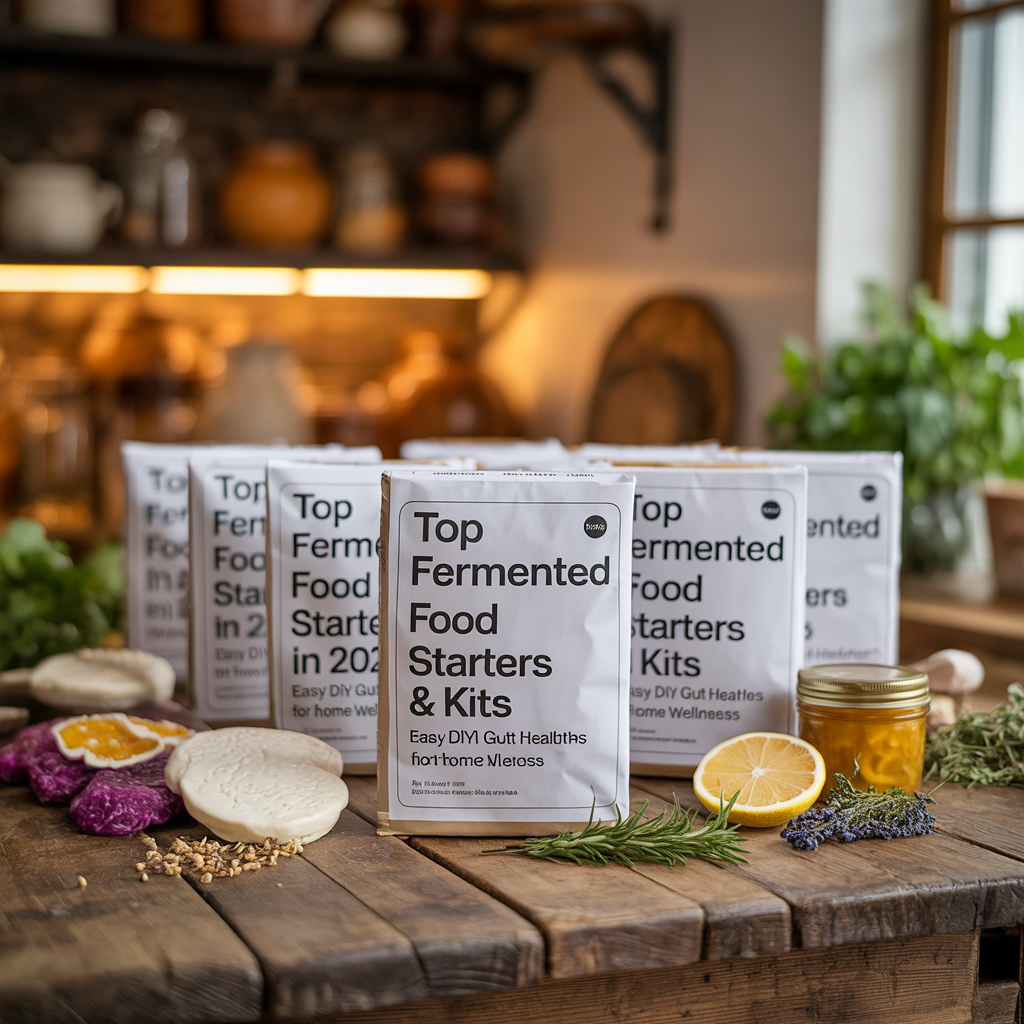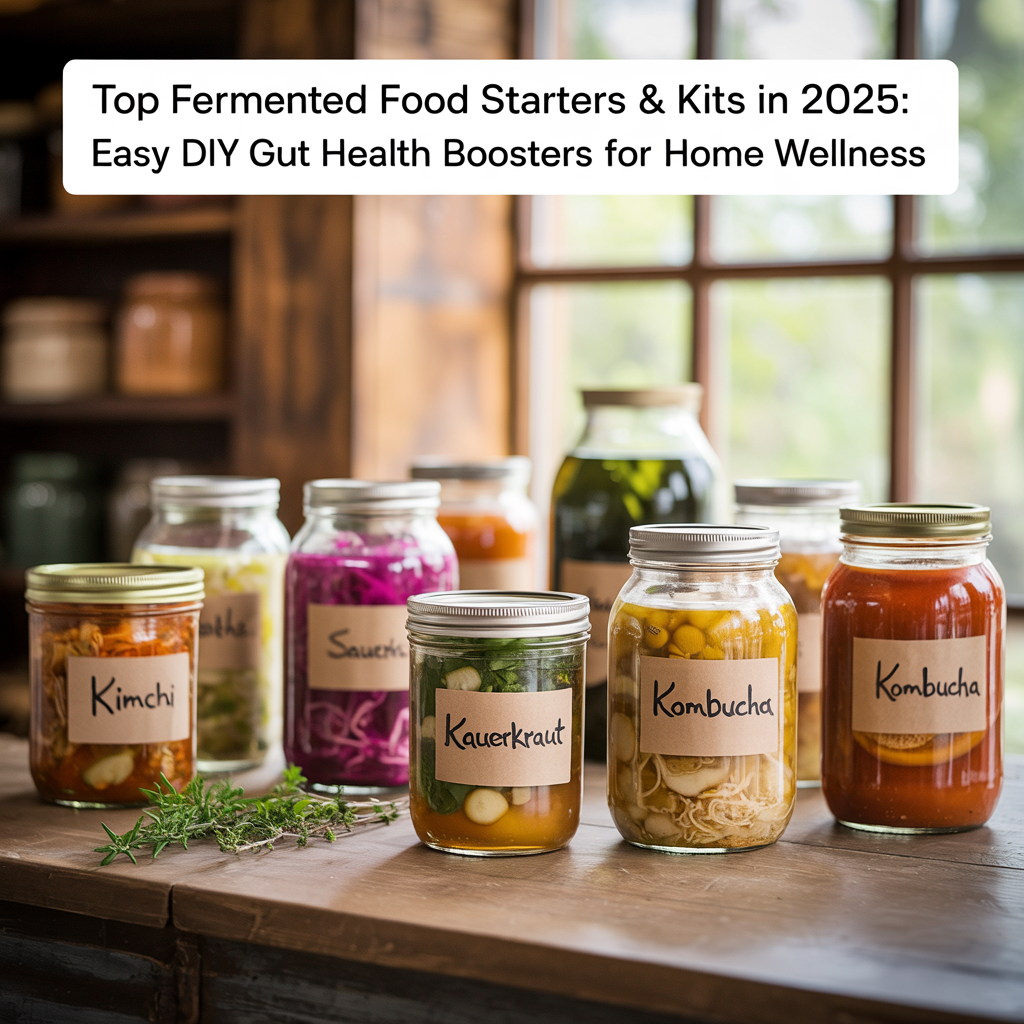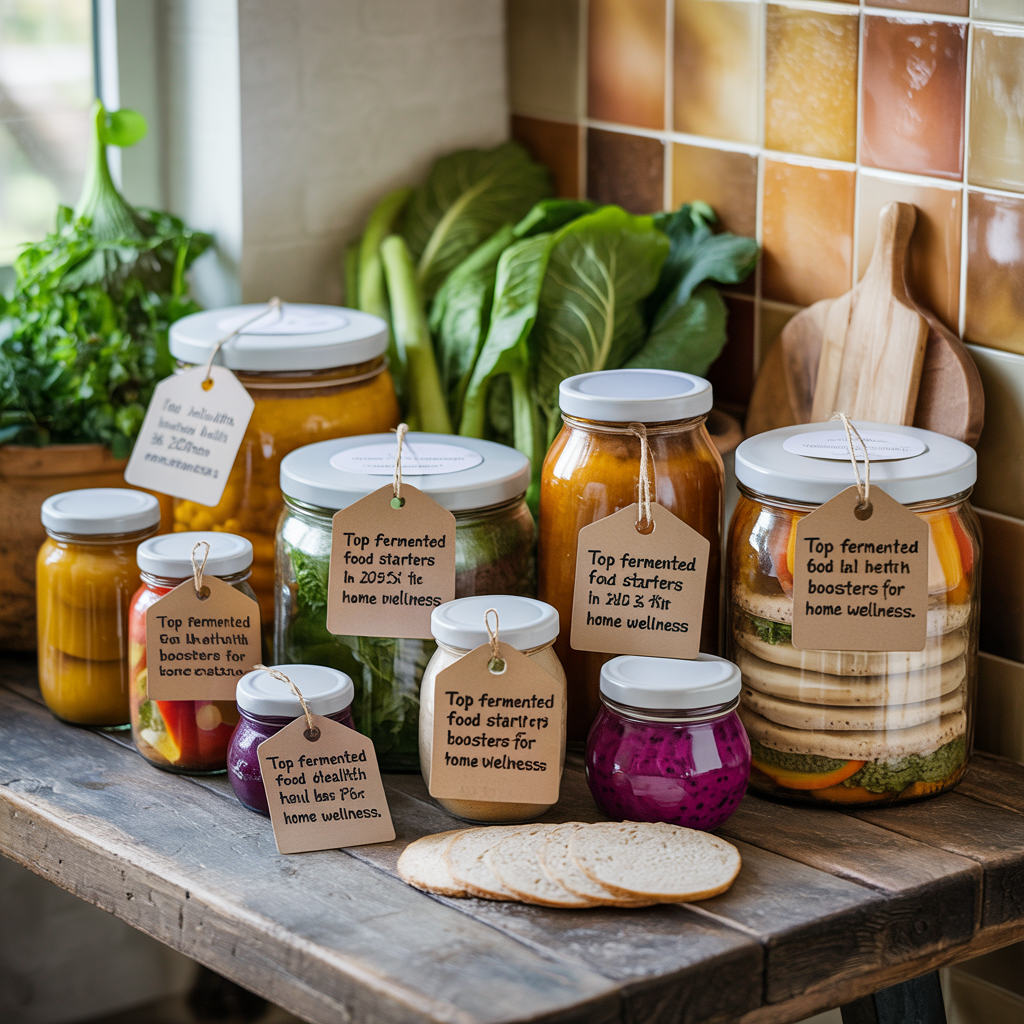
The year my digestion finally rebelled, I was eating store-bought yogurt with abandon, convinced I was doing wonders for my gut. Spoiler: I ended up even more bloated. It wasn’t until a friend handed me a chunky jar of homemade sauerkraut—with a wild sparkle in her eye—that everything changed. Suddenly, fermentation wasn’t just about taste; it was about tuning into the living rhythms of my own microbiome. In 2025, fermentation kits are making this intimate science as simple as a walk to your kitchen counter. Let’s talk about how these kits have become the new go-to for home wellness and sustainable gut health, ditching the pills for flavor, fun, and a little bubbling adventure.
The Homemade Fermentation Awakening
I’ll be honest—my gut health journey started with desperation. After months of bloating that made me look six months pregnant by evening, I’d tried every commercial probiotic on the shelf. Expensive capsules, fancy powders, trendy drinks. Nothing stuck. My digestive system remained a mystery I couldn’t solve. Then I discovered DIY probiotic food starters, and everything changed. The first time I saw my homemade kimchi start bubbling on the kitchen counter, something clicked. This wasn’t just food—something was genuinely alive in that jar. The surprise fizz when I opened my first successful kombucha batch made me realize I’d been missing the point entirely. Research shows that doing fermentation at home can lead to higher probiotic counts and personalized nutrition, but experiencing it firsthand felt revolutionary.
Why Kitchen Counter Fermentation Hits Different
There’s something tangible about watching fermentation happen in real time. Commercial probiotics arrive in sterile bottles with clinical labels. But when you’re making probiotic foods at home, you witness the entire process. The cabbage changes color. The liquid develops that distinctive tang. You can actually see the bubbles forming as beneficial bacteria do their work. This hands-on approach to gut microbiome health feels more connected than swallowing pills. You control every ingredient. No mysterious additives or processing methods. Just vegetables, salt, and time working together the way they have for centuries. Fermentation is a centuries-old kitchen process that’s been revived in modern wellness culture, and I understand why. When your gut is struggling, you want solutions that feel real and immediate. Home fermenting with starter kits offers exactly that—tangible results you can see, smell, and taste.
From Skeptic to Fermenting Convert
Many of us turn to DIY probiotic food starters after commercial products disappoint. I was definitely in that camp. Those expensive probiotic supplements never seemed to address my specific digestive issues. But making my own fermented foods? The difference was noticeable within weeks. The beauty of home fermentation lies in its simplicity. You don’t need a laboratory or expensive equipment. Modern starter kits bridge the gap between ancestral wisdom and modern convenience perfectly. Stainless steel fermenting kits with wide-mouth glass jars and airlocks make the process foolproof while maintaining that hands-on connection to your food. Home fermenting has become a practical biohacking tool for those who want control over ingredients and probiotic potency. When you make your own sauerkraut or kombucha, you’re not just following a recipe—you’re participating in a living process that’s been supporting human health for millennia.
“Fermentation is the oldest biohack—and still one of the best.”
That first successful batch taught me something important: gut health isn’t just about consuming probiotics. It’s about understanding and nurturing the complex ecosystem inside us. And sometimes, the best way to do that is by getting your hands dirty in your own kitchen.

Best Fermentation Kits 2025: Picking Your DIY Probiotic Powerhouse
I’ve spent months testing the best fermentation kits 2025 has to offer, and honestly? The market has gotten serious about making home fermentation accessible. Modern kits address convenience, variety, and dietary preferences like never before—whether you’re vegan, keto, or dealing with dairy sensitivities.
“The best DIY fermentation kits in 2025 are about flavor, ease, and real bacteria—not hype.”
What’s Actually in These Complete Fermentation Kits
The Cultures for Health Fermented Vegetable Master sets the bar high. You get glass jars, airlocks, fermentation weights, and a solid recipe guide. It’s perfect if you want to dive into sauerkraut and kimchi without guessing what equipment you need.
For kombucha starter kit enthusiasts, the Kombucha Kamp Deluxe remains unbeatable. They include organic tea, a live SCOBY, glass bottles for second fermentation, and pH test strips. Everything’s there—no last-minute Amazon orders for missing pieces.
The Euro Cuisine Greek Yogurt Maker takes a different approach. It’s electric, includes starter cultures, and appeals to people who want consistent results without temperature guesswork. Research shows that fermented foods like yogurt can significantly improve gut microbiome diversity.
Mason Jars vs. Airlock Loyalists: The Great Divide
Here’s where things get interesting. Some people absolutely love mason jar compatibility—and I get it. The Nourished Essentials Easy Fermenter works with standard wide-mouth jars you probably already own. Dishwasher safe, versatile, budget-friendly.
But then there are the airlock die-hards. They swear by dedicated fermentation vessels with proper vacuum systems. Stainless steel fermenting kits win points for durability and ease of cleaning, though they’re pricier upfront.
Matching Kits to Your Fermentation Style
Newbies should consider the Country Trading Co. Kefir Kit. It includes live kefir grains, strainer, and fermentation jar—plus it’s forgiving if you mess up timing. The learning curve is gentle.
Bread makers gravitate toward the Fermentaholics Sourdough Kit. It comes with heirloom starter and a proofing jar designed specifically for bread fermentation. Different beast entirely from vegetable ferments.
Vegan fermentation kits have improved dramatically. Many now include plant-based starters and dairy-free options, addressing the growing demand for inclusive probiotic solutions.
The Reality Check
Not all fermentation kit reviews mention this, but success depends heavily on your environment. Temperature fluctuations, water quality, and even seasonal changes affect results. The best kits include thermometers and detailed troubleshooting guides.
Stainless steel components last longer, but glass lets you watch the fermentation process. Wide-mouth jars make cleaning easier, but narrow necks sometimes ferment more evenly. There’s no perfect setup—just what works for your kitchen and lifestyle.

Beyond the Jar: Tips, Troubles, and Tasty Triumphs in Home Fermentation
Let’s be honest—fermentation tips for beginners often skip the messy reality. I’ve had my share of kitchen disasters. The sauerkraut that turned to mush after three days. The kefir that literally exploded overnight, coating my counter in fermented milk. These failures taught me more than any perfect batch ever could.
Learning from Fermentation Fails
My mushy kraut disaster happened because I skipped proper salt ratios and used chlorinated water. Research shows that proper prep and kit selection make home fermentation accessible, but I learned the hard way that shortcuts backfire. Mason jar fermentation kits are especially forgiving for beginners—they come with measured weights and proper airlock lids that prevent the common mistakes I made early on.
When my kefir exploded, I realized I’d overfilled the jar and ignored temperature warnings. Fermentation kit components like airlock lids and fermentation weights exist for good reasons—they reduce the risk of bad bacteria and messy overflows.
The Science Behind Successful Sauerkraut Fermentation
Getting sauerkraut fermentation right requires attention to details that seem minor but matter hugely. Non-chlorinated water is essential because chlorine kills the beneficial bacteria you’re trying to cultivate. Room temperature monitoring becomes crucial—I keep my jars between 65-72°F for consistent results.
Cleanliness can’t be overstated. Common first-timer mistakes include skipping thorough hand cleaning, which risks mold contamination. I learned to spot healthy fermentation bubbles in my probiotic sauerkraut pickles—those tiny bubbles rising through the brine signal active bacterial work.
“Don’t fear the fizz—those bubbles mean your jar’s alive and kicking.”
Weather affects fermentation timing more than most realize. Hot summer days speed everything up, while winter ferments take longer. I monitor by taste rather than strict schedules now.
Beyond Basic Fermented Vegetables
Once cabbage becomes routine, creativity kicks in. I’ve successfully fermented carrots, beets, and even oats for breakfast porridge. Coconut milk ferments into surprisingly tangy yogurt alternatives. These unusual experiments keep the hobby exciting and expand your probiotic variety.
Typical beginner ferments include cucumbers for natural pickles, bread dough for sourdough starters, and green tea for kombucha. Each teaches different techniques while building confidence with fermentation kit components.
The key insight? Fermentation failures aren’t really failures—they’re education. Every mushy batch, every mold spot, every explosion teaches something valuable about timing, temperature, or technique. Modern fermentation kits make the learning curve gentler, but there’s still artistry involved.
Start simple with proven fermented vegetables like cabbage or cucumbers. Master the basics before attempting coconut yogurt or fermented oats. Your gut microbiome—and your kitchen—will thank you for the methodical approach.

Gut Health Game-Changer: The Real Benefits of DIY Fermentation
When I first started making my own sauerkraut, I had no idea I was stepping into a world that would completely transform my understanding of gut microbiome health. The difference between homemade ferments and their store-bought counterparts isn’t just about taste—it’s about creating a living ecosystem in your kitchen that delivers probiotic rich foods with unmatched potency.
Why Homemade Ferments Pack More Punch
Store-bought fermented foods often disappoint when it comes to live cultures. Many undergo pasteurization, which kills the beneficial bacteria we’re actually seeking. Research shows that DIY fermenting leads to a richer diversity of probiotics, and I’ve experienced this firsthand. My homemade kimchi contains dozens of bacterial strains that simply don’t survive commercial processing.
The customization factor is huge too. I can control salt levels, add specific herbs for targeted health benefits fermented foods provide, and avoid the preservatives and stabilizers that crowd ingredient lists on jarred products. My fermentation experiments have ranged from ginger-heavy sauerkraut to turmeric-spiced carrots—each batch tailored to my family’s preferences and health goals.
The Science Behind Homemade Gut Health
Here’s where things get interesting. Studies indicate that unpasteurized sauerkraut can significantly boost Bifidobacteria levels and ease IBS symptoms. During my own “ferment and flourish” experiment last year, I tracked my digestive symptoms while eating homemade ferments daily. The prolonged bloating relief was remarkable—something I hadn’t achieved with store-bought options.
Research from PMC studies confirms that microbiome and fermented foods work together to improve gut microbiome diversity and digestion, with potential body fat reduction benefits. Fermentation increases nutrient bioavailability too, which explains why my sugar cravings diminished after incorporating regular homemade ferments into my routine.
The Sustainability Sweet Spot
Beyond gut health, cost-effective DIY fermentation addresses environmental concerns that keep me up at night. Each jar I make eliminates plastic packaging, reduces food waste (I ferment vegetables before they spoil), and cuts down on transportation emissions from mass manufacturing.
The economics are compelling. A head of cabbage costs me about two dollars and yields enough sauerkraut for weeks. Compare that to premium probiotic supplements or specialty fermented products, and the savings add up quickly.
“Fermenting at home is an act of self-reliance—and an invitation to taste the world inside your jar.”
This journey has taught me that diversity in the gut microbiome links directly to health resilience. Home ferments avoid preservatives while maximizing beneficial bacteria, creating a personalized probiotic powerhouse that no commercial product can match. The bubbling jars on my counter represent more than food preparation—they’re a daily investment in long-term wellness that connects me to ancestral wisdom while supporting modern health goals.
TL;DR: The best fermentation kits in 2025 bring live probiotics and fun into your kitchen. With minimal effort, you can craft gut-friendly foods that beat store-bought options—tastier, more nourishing, and deeply satisfying. Home fermenters: your microbiome (and your taste buds) will thank you.


